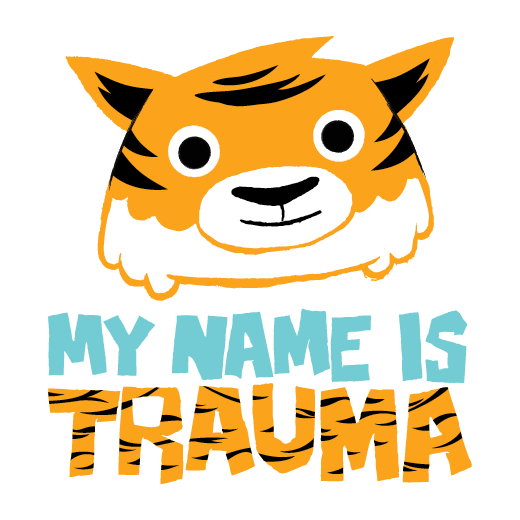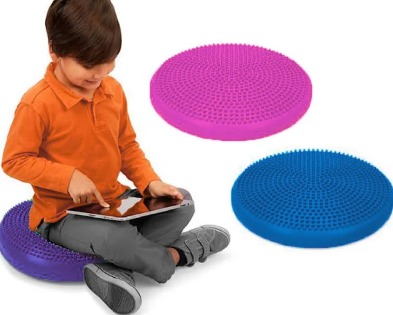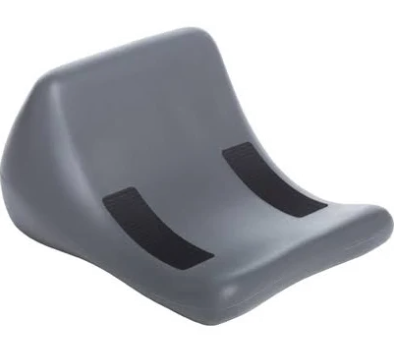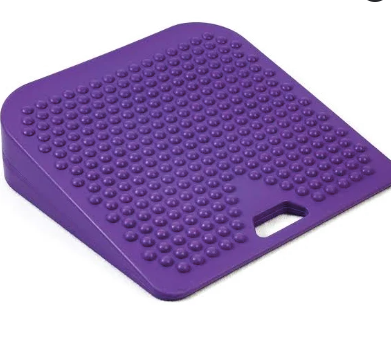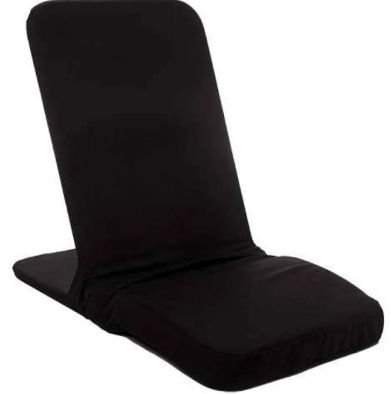Adaptive Seats for All Abilities
Image description: A wooden chair, with various levels of slats that can be adjusted for seat, foot rest, and table.
Take a seat! We’re here to discuss a piece of furniture that billions use every day.
When you think of chairs, what comes to mind? Dining chairs, school chairs, bean bags, office chairs, wheelchairs, bus seats, car seats, stools, couches, recliners—that help you get comfortable to study, eat, watch TV with your family, travel long distances, wait for appointments, hang out with friends, work at your job, and countless other actions of everyday life.
Not only are chairs so ubiquitous and integrated in our everyday living landscapes, but if you’re able-bodied, our ability to sit in a chair can also be taken for granted. Just like clothes, bike helmets, and other objects and items that conform to human bodies, some people also need to be choosy about the chairs they use in their daily lives.
What would your ‘perfect’ chair have?
Think about your or ideal chair that you would need to enjoy all the things you’d like to enjoy for a specific activity (eg. Gaming at your desk, going on a road trip):
Would the cushioning be comfortable, or firm?
Would it be long, like a chaise, or tall, like a bar stool?
Would you want arm rests, or none?
If you have arm rests, would they be soft, or firm? Perhaps with a cup holder?
Would your chair allow you to recline back a little, or a lot?
Would your chair allow you to wiggle and adjust your body throughout the day?
Would your chair let you put up your feet, or would you always want them firm on the ground?
Would there be a stand for a phone or tablet, with communication easy to reach?
Does it have some kind of belt or table in front of you, to keep you upright?
Would your chair be easy to carry, in case you needed to sit down in public?
Do you prefer to stand, wiggle, walk, or even cycle at a desk rather than sit?
For some people, these design choices are not just for aesthetic or comfort, but serious, effective choices to make for living well and having a better quality of life.
Especially considering how much people sit throughout the day, a chair that fits your body and supports your activities can help reduce pain and prevent more harmful conditions as years go by.
Before we get into the different types of seats and sitting options, let’s mention some of the benefits of finding the right sitting for you.
Benefits of Alternative Seats and Sitting
In the above video, physical and occupational therapists explain the Rifton Compass Chair and how it can support children in the classroom. While we don’t specifically endorse or are sponsored by any of the following chairs and seats, we work with clients on an individual basis with their body and activity needs to suggest the right fit.
The right seating:
Can help seaters be on task, staying focus and engaged for longer
Can assist with staying upright, for those with poor postural control
Can assist with sensory input/regulate your sensory system
Can help with inclusion in the classroom
Can be set up/mounted with physical communication options (eg. Switches, eye gaze board, tablet) for ease of use
Can help with blood flow and circulation in the body (hate that fuzzy feeling when you sit in the ‘wrong way’ for too long? we do too!)
Types of Alternative Seats and Sitting Accomodations
The following examples are a non-exhaustive list of alternative seating and sitting options our Coaches may use here in Edmonton. Our coaches routinely help children with disabilities discover, choose, and install seats and sitting options that work best for them. There is no one-size-fits-all option, so scroll through and see what’s out there:
Therapy Ball/Exercise Ball/Ball Chair
As a kid, we’ve had the experience of sitting on, or playing with, large exercise balls at a gym or at school. In exercise settings, exercise balls are often valued for their ability to create instability, engaging more muscles than if you were on a more stable surface.
Some users sit only on the exercise ball, while other brands have designed chairs where the exercise ball is nested in a chair-like frame (like the above photo).
Ball chairs allow for slight up-and-down bouncing, balancing, and engaging more muscles than a typical chair to stay upright.
Rocker Chair (Zuma)
A rocker chair looks like a regular chair you’d find in a classroom, but instead of the legs, the base of the chair is like a rocking chair.
Like the name, it provides a subtle rocking motion while you sit, which can be powered by your legs, back, or a combination of muscles.
Rocking is a common type of vestibular stimulation that can be alerting for some users and calming for others. If you have a tendency to tip backwards in a typical school chair, a rocker chair may help satisfy or catch seaters who like to tilt.
Wobble Chairs (Kore)
Wobble chairs have round bottoms, where instability is deliberate and meant to benefit the user.
The wobble allows a person to continually activate their legs and core, letting them stay active, keep blood flowing, and maintain focus though subtle rocking and wiggling.
Wobble chairs can help provide vestibular stimulation through rocking and wiggling and are great for children who need to keep moving to stay alert.
T-Stool
A T-Stool is a flat seating surface with only one leg that rests on the floor. T-Stools require a user to find their own center of gravity to keep the stool upright.
Activity-wise, a T-Stool allows a user to rock very slightly in all directions. T-Stools can promote core strength, balance, functional posture, and coordination. They can also promote focus, alertness, attention for students who need more movement.
Cushions, Pillows, and Wedges
Instead of buying a completely unique chair, finding the right cushion, pillow, or wedge (or a combination) can be a great option. To some, a cushion also allows their seating option to ‘blend in’ (ie, you can still use the same chair as everyone else)
For many schools or clinics, the thought of replacing every single chair can be financially overwhelming, but cushions can be added and moved easily from one class to the next, or even for floor sitting.
Dynamic Seating Chairs
In the above video, a person demonstrates the force-absorbing abilities of a dynamic seating chair.
Dynamic seating can be used for active persons with increased muscle tone, like those who may be prone to breaking other types of equipment, not be used to sitting for long periods, and may need a lot of movement without being completely rocked, bounced, or tilted off of a chair.
Dynamic seating protects users from injuries, and can maintain a user’s posture while still allowing movement.
Other Chairs, Seats, and Stools
Image description: Two young people sit in two different examples of the Skillbuilders Modular Seating System. Both of their chairs are different sizes, one chair has larger wheels than the other, one has handlebars and the other does not; both have multi-point seat belts.
Now that you’ve got a better idea of different types and styles of seats, here’s a non-exhaustive list of even more chairs and seats you can consider:
It's important to keep in mind that everyone’s sitting preferences are different, and what works for one may not work for another.
Finding the Right Chair for You
Our team of Occupational and Physical Therapists in Edmonton are trained to assess and recommend appropriate seating options for your child.
Moreover, they can also help you test and install the chair in your home, school, car, etc and work with you and your child to get used to, and thrive, in your shiny new seat!
Looking for assessment, consultation, or more about the best seats for children and youth with disabilities in Edmonton and Alberta? Fill out an Intake Form!


